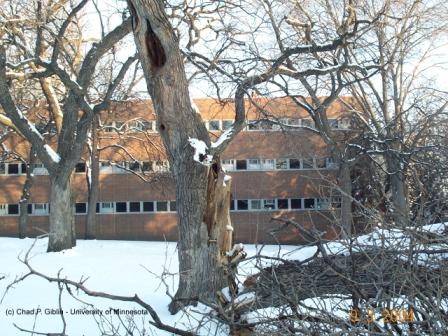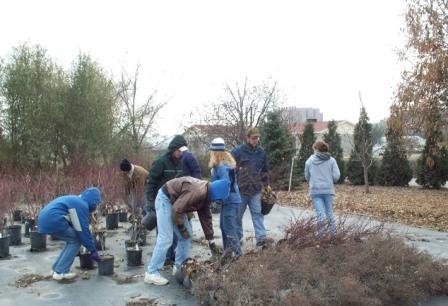Here in Minnesota one of the things that we need to worry about is the cold. Over the winter we can see temperatures down into the -30s (even the -40s in the Northern part of the state) and it can damage many of the plants that we grow. The tops of the trees are usually able to handle these types of temperatures — though a good heavy snowfall can cause a limb to collapse now and again.

The bigger problem is with roots which aren’t able to handle the cold like the top of a plant can. Once you get 10 degrees or so below freezing you’ve killed the roots of most plants. Fortunately the ground is a great insulator and doesn’t get nearly as cold as you’d think. Once you get two or three inches under the surface of the soil temperatures will hover right around freezing for most of the winter. The plants that are most susceptible to cold are those that are in containers because their roots are above the soil’s surface. Nursery growers usually protect containers from the cold by consolidating them (pushing them together as in the picture below).

These containers are then covered with a layer of polyethylene fabric, about 6 inches of straw, and then another layer of polyethylene fabric. Temperatures under the fabric rarely go below 26 degrees or so — even when outside temperatures stay around -20. Most plants come out fine — our biggest problem is that sometimes voles and mice will take up residence under the tarp and eat the plants — which isn’t a big deal unless its a research project — in those cases we will often use poisons or, more frequently, repellents.
The only thing better than this method is snow. If we could count on snow every year we wouldn’t bother covering the plants at all. Snow is the best insulator that we have. Under snow temperatures rarely go below 29 degrees or so. So, despite the traffic problems that snow causes, nurserymen and landscapers are always happy to see snow on the ground before the really low temperatures hit.
Nope — sawdust beds will work here — but they’re not common. We have more straw (and dried sudan grass — frequently used as a cover crop) than sawdust I guess!
30 below, huh?
I don’t even know what to think about that.
And you must be psychic (psycho?) as I just now, today, completed a grant proposal on “overwintering survival of containerized perennials”… wherein I discuss the issues associated with overwintering in Virginia (zones 6a to 8a). Our big problem is temperature fluctuations – a week of warm and “sproing!” – stuff starts growing under the blankets – followed by freezing temps. Sounds like you just freeze, and stay frozen!
Holly I’m trying out a technique that I learned from noted pro gardener janet macunovich – I made a pit for my canna lilies 18 – 24 inches down (Janet refers to it as the canna grave :)) covered with soil and on the surfuce a couple additional inches of shredded silver maple leaves. I’m in zone 5 chicago and she’s in zone 5 in Michigan – she’s done this for years and works with cannas and some of the other more tender fleshy perennials like dahlias and caladiums.
We’re glad to have you, Psychic! We’ll be up and running again next week.
I wonder if you would comment on some research I found that conflicts with the numbers presented?
http://bioeng.ca/docs/journal/28/28_2_77_ocr.pdf
This paper shows that the temperature at abo
ut 1 foot below surface goes down to about -10 C. the 26 deg you mention would be about -6C and so all plants should be dead in Ottawa. I also wonder about the statement that 3 inches below surface it hovers around zero. Ottawa would have a freezing dept of about 4 feet – it is hard to believe that anything from 3 inches to 4 feet down is at about freezing?
Hi Robert,
Very interesting! As soon as I got your note I started looking at other papers — and the one that you sent is the only one that records such low temps — most are in the range I mentioned in the above post (around 0 degrees C plus or minus a few). Here’s one that I found particularly interesting http://pubs.aic.ca/doi/pdf/10.4141/cjss85-012 Figure 1 on page 12 is particularly useful. So to comment — If the soils of Ottawa regularly see the temperatures mentioned in the paper that you sent I would think that would be limiting to many species of trees — but I question whether that paper accurately represents the soil climate for most soils in Ottawa. If you find other papers that agree with this paper please send them along though — this is very interesting!